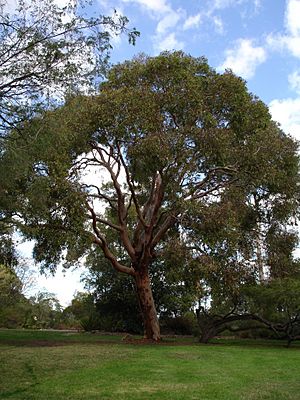Angophora facts for kids
Quick facts for kids Angophora |
|
|---|---|
 |
|
| Angophora costata | |
| Scientific classification |
|
| Kingdom: | Plantae |
| Clade: | Tracheophytes |
| Clade: | Angiosperms |
| Clade: | Eudicots |
| Clade: | Rosids |
| Order: | Myrtales |
| Family: | Myrtaceae |
| Subfamily: | Myrtoideae |
| Tribe: | Eucalypteae |
| Genus: | Angophora Cav. |
| Species | |
|
See text |
|
Angophora is a group of nine types of trees and shrubs. They belong to the Myrtaceae family, which also includes Eucalyptus trees. You can only find Angophora plants in eastern Australia. They are special because their young and adult leaves grow in opposite pairs. Their flowers have small petals and sepals that are not joined together. The fruit is a thin, often ribbed capsule. You can find these plants from Queensland down to eastern Victoria.
Contents
What Angophora Plants Look Like
Angophora plants are usually trees, but sometimes they are shrubs. Most of them have rough bark. But one kind, the A. costata, has smooth bark.
Their young leaves are usually hairy. They also have tiny oil glands that stick out. Both young and adult leaves grow in pairs, directly across from each other. Adult leaves are usually smooth and lighter in color on their underside.
The flower buds grow in small groups of three or seven. Each flower has four or five tiny sepals. These sepals look like small bumps on the edge of the flower cup. There are also four or five round petals that overlap. Many creamy white stamens grow in circles inside the flower.
Unlike Eucalyptus and Corymbia trees, the petals and sepals of Angophora flowers do not join together to form a cap. The fruit is a thin, slightly woody capsule. It is often hairy and has long ridges.
About the Name and Family
The name Angophora was first officially used in 1797. It was described by Antonio José Cavanilles in his book Icones et Descriptiones Plantarum.
Angophora is very closely related to Corymbia and Eucalyptus trees. All three groups are often called "eucalypts." Together, eucalypts are a very important part of many Australian ecosystems. Scientists have known about the connections between these trees for a long time. However, they don't always agree on how to classify them.
Some scientists have suggested putting Angophora and Corymbia into the Eucalyptus group. But others quickly disagreed with this idea. Some experts still keep Angophora as its own separate group. The discussion about how to classify them continues.
Early European settlers in Australia nicknamed Angophora species "apples." They thought these trees looked like apple trees. Many of them are still commonly called "apples" today.
Angophora Species
Here is a list of Angophora species that are currently accepted by the Australian Plant Census as of March 2020:
- Angophora bakeri E.C.Hall - NSW
- Angophora bakeri E.C.Hall subsp. bakeri - NSW
- Angophora bakeri subsp. crassifolia G.J.Leach - NSW
- Angophora costata (Gaertn.) Britten – Qld, NSW
- Angophora costata (Gaertn.) Britten subsp. costata – Qld, NSW
- Angophora costata subsp. euryphylla L.A.S.Johnson ex G.J.Leach – NSW
- Angophora floribunda (Sm.) Sweet - Qld, NSW, Vic.
- Angophora hispida (Sm.) Blaxell - NSW
- Angophora inopina K.D.Hill - NSW
- Angophora leiocarpa (L.A.S.Johnson ex G.J.Leach) K.R.Thiele & Ladiges - NSW, Qld.
- Angophora melanoxylon R.T.Baker - Qld., NSW
- Angophora robur L.A.SJohnson & K.D.Hill - NSW
- Angophora subvelutina F.Muell. - NSW
- Angophora woodsiana F.M.Bailey - Qld., NSW
Where Angophora Plants Grow
You can find Angophora trees and shrubs along the coast of Queensland, New South Wales, and Victoria. They grow from the Atherton Tableland in Queensland all the way down to eastern Victoria.
Images for kids
-
A. hispida buds & flowers
-
A. hispida fruit
-
A. hispida lignotuber regrowth after fire
-
A. hispida opposite and decussate leaves
See also
 In Spanish: Angophora para niños
In Spanish: Angophora para niños





